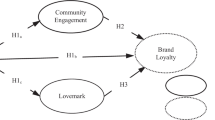Abstract
This paper investigates the nature of the dialogue between marketers and consumers, and in particular, considers some aspects of the effect of the personality of agency creatives (those who develop and design advertising) on that dialogue. The research was conducted with eight advertising creatives and one branding consultant, and all were encouraged to talk about their experiences in creating and interpreting brand personalities. They were asked to indicate what kind of animal they most resembled personally, and how this had affected their approach to their creative work. The creatives were also asked to bring samples of their best work, a task which they interpreted as meaning samples of their favourite work. This encouraged discussion about the relationship between the individual and the communication. The responses made it apparent that the personalities of creatives impact on the final brand personality firstly insofar as the creatives will tend to produce work that reflects their own personalities, and secondly insofar as clients will tend to choose agencies that have similar brand personalities to those of the brand being promoted.


Similar content being viewed by others
References
Guthrie, S. E. (1993) ‘Faces in the Clouds: A New Theory of Religion’, Oxford University Press, New York.
Guthrie, S. E. (1997) ‘Anthropomorphism: A definition and a theory in Mitchell, R.W., Thompson, N.S. and Miles, H.L. (eds) Anthropomorphism, Anecdotes and Animals. State University of New York Press, Albany, NY.
Clark, K. and Fujimoto, T. (1990) ‘The power of product integrity’, Business Review (November/December), pp. 107–118.
Harris, F. and DeChernatony, L. (2001) ‘Corporate branding and corporate brand performance’, European Journal of Marketing, Vol. 35, No. 3–4, pp. 441–456.
Nandan, S. (2005) ‘An exploration of the brand identity–brand image linkage: A communication perspective’, Journal of Brand Management, Vol. 12, No. 4, pp. 264–278.
Park, C. W., Jaworski, B. J. and MacInnis, D. J. (1986) ‘Strategic brand concept-image management’, Journal of Marketing, Vol. 50, (October) pp. 135–145.
Corbin, J. and Strauss, A. (1990) ‘Grounded theory research: Procedures, canons and evaluative criteria’, Qualitative Sociology, Vol. 13, No. 1, pp. 3–21.
Bartlett, D. and Payne, S. (1997) ‘Grounded theory—its basis, rationale and procedures in McKenzie, G., Powell, J. and Usher, R. (eds) Understanding Social Research; Perspectives on Methodology and Practice. Falmer Press, London, pp. 173–195.
Ruekert, R. W. and Walker Jr, O. C. (1987) ‘Marketing's interaction with other functional units: A conceptual framework and empirical evidence’, Journal of Marketing, Vol. 51 (January), pp. 1–19.
Reitz, H. J. (1977) ‘Behavior in Organisations’, Richard D. Irwin Inc., Homewood, IL.
Hellreigel, D. and Slocum Jr, J. W. (1988) ‘Management 5th edn, Addison-Wesley, London.
Hodge, B. J. and Anthony, W. P. (1991) ‘Organisation Theory—A Strategic Approach, Allyn and Bacon, London.
Robbins, S. P. (1991) ‘Organisational Behavior—Concepts, Controversies and Applications 5th edn Prentice-Hall, London, pp. 173–195.
Daft, R. L. (1998) ‘Organisation Theory and Design 6th edn South Western College Publishing, Ohio.
Hatch, M. J. (1997) ‘Organisation Theory—Modern Symbolic and Postmodern Perspectives’, University Press, Oxford.
Hochschild, A. R. (2003) ‘The Managed Heart: Commercialisation of Human Feeling’, University of California Press, Berkeley.
Deetz, S. A. (1992) ‘Democracy in the Age of Corporate Colonization: Developments in the Communication and the Politics of Everyday Life’, State University of New York Press, Albany, NY.
Mantovani, G. (1996) ‘New Communication Environments: From Everyday to Virtual’, Taylor & Francis, London.
Blythe, J. (2006) ‘Essentials of Marketing Communications 3/e’, Thomson, London.
Lund, F. H. (1925) ‘The psychology of belief, The law of primacy in persuasion’, Journal of Abnormal and Social Psychology, Vol. 20, pp. 183–191.
Author information
Authors and Affiliations
Corresponding author
Rights and permissions
About this article
Cite this article
Blythe, J. Advertising creatives and brand personality: A grounded theory perspective. J Brand Manag 14, 284–294 (2007). https://doi.org/10.1057/palgrave.bm.2550071
Received:
Revised:
Published:
Issue Date:
DOI: https://doi.org/10.1057/palgrave.bm.2550071




